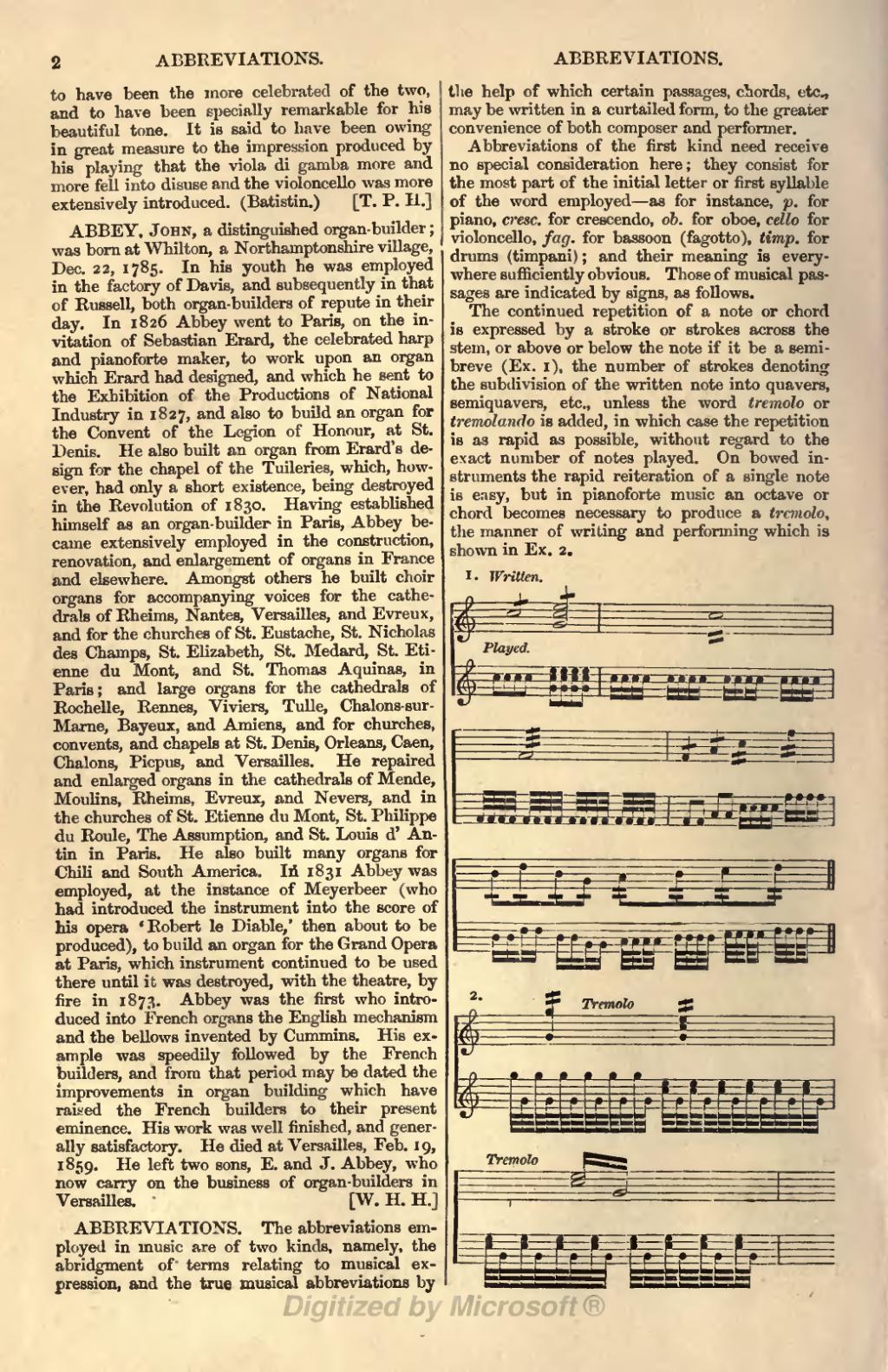to have been the more celebrated of the two, and to have been specially remarkable for his beautiful tone. It is said to have been owing in great measure to the impression produced by his playing that the viola di gamba more and more fell into disuse and the violoncello was more extensively introduced. (Batistin.)
ABBEY, John, a distinguished organ-builder; was born at Whilton, a Northamptonshire village, Dec. 22, 1785. In his youth he was employed in the factory of Davis, and subsequently in that of Russell, both organ-builders of repute in their day. In 1826 Abbey went to Paris, on the invitation of Sebastian Erard, the celebrated harp and pianoforte maker, to work upon an organ which Erard had designed, and which he sent to the Exhibition of the Productions of National Industry in 1827, and also to build an organ for the Convent of the Legion of Honour, at St. Denis. He also built an organ from Erard's design for the chapel of the Tuileries, which, however, had only a short existence, being destroyed in the Revolution of 1830. Having established himself as an organ-builder in Paris, Abbey became extensively employed in the construction, renovation, and enlargement of organs in France and elsewhere. Amongst others he built choir organs for accompanying voices for the cathedrals of Rheims, Nantes, Versailles, and Evreux, and for the churches of St. Eustache, St. Nicholas des Champs, St. Elizabeth, St. Medard, St. Etienne du Mont, and St. Thomas Aquinas, in Paris; and large organs for the cathedrals of Rochelle, Rennes, Viviers, Tulle, Chalons-sur-Marne, Bayeux, and Amiens, and for churches, convents, and chapels at St. Denis, Orleans, Caen, Chalons, Picpus, and Versailles. He repaired and enlarged organs in the cathedrals of Mende, Moulins, Rheims, Evreux, and Nevers, and in the churches of St. Etienne du Mont, St. Philippe du Roule, The Assumption, and St. Louis d' Antin in Paris. He also built many organs for Chili and South America. In 1831 Abbey was employed, at the instance of Meyerbeer (who had introduced the instrument into the score of his opera 'Robert le Diable,' then about to be produced), to build an organ for the Grand Opera at Paris, which instrument continued to be used there until it was destroyed, with the theatre, by fire in 1873. Abbey was the first who introduced into French organs the English mechanism and the bellows invented by Cummins. His example was speedily followed by the French builders, and from that period may be dated the improvements in organ building which have raised the French builders to their present eminence. His work was well finished, and generally satisfactory. He died at Versailles, Feb. 19, 1859. He left two sons, E. and J. Abbey, who now carry on the business of organ-builders in Versailles.
ABBREVIATIONS. The abbreviations employed in music are of two kinds, namely, the abridgment of terms relating to musical expression, and the true musical abbreviations by the help of which certain passages, chords, etc., may be written in a curtailed form, to the greater convenience of both composer and performer.
Abbreviations of the first kind need receive no special consideration here; they consist for the most part of the initial letter or first syllable of the word employed—as for instance, p. for piano, cresc. for crescendo, ob. for oboe, cello for violoncello, fag. for bassoon (fagotto), timp. for drums (timpani); and their meaning is everywhere sufficiently obvious. Those of musical passages are indicated by signs, as follows.
The continued repetition of a note or chord is expressed by a stroke or strokes across the stem, or above or below the note if it be a semi-breve (Ex. 1), the number of strokes denoting the subdivision of the written note into quavers, semiquavers, etc., unless the word tremolo or tremolando is added, in which case the repetition is as rapid as possible, without regard to the exact number of notes played. On bowed instruments the rapid reiteration of a single note is easy, but in pianoforte music an octave or chord becomes necessary to produce a tremolo, the manner of writing and performing which is shown in Ex. 2.


